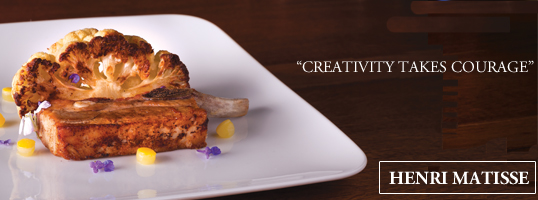How to Plate Food to Make it Look More Appealing

As we discussed in our recent exploration of the current bowl food trend, when it comes to serving up food, plating trends come and go. However, there are some ‘rules’ about food presentation that chefs tend to stick to season after season.
Appealing plates are a careful balance of colour, texture and layering. And of course, there’s the small matter of selecting crockery that acts as the perfect canvas too! In the age when everyone’s taking snaps of their food, you can’t afford for your dishes to be less than picture-perfect. Here are the key ingredients for aesthetically perfect plates.
A splash of colour
Health professionals encourage us to eat a rainbow of foods, but you don’t necessarily have to use a sea of brightly coloured ingredients to produce an attractive plate. Some of the most successful restaurants take their colour cues from the seasons, creating dishes that effectively use contrasting and complementary colours while taking inspiration from nature itself. The food at Michelin-starred Noma in Copenhagen is a good example of this aesthetic.
There was a time in the restaurant world when seemingly every dish came with a garnish, often to add a contrasting colour irrespective of whether the ingredient was required – as you can discover from our history of food presentation trends infographic. Now, garnishes tend to be added only if they add something to the dish aside from just colour.
A touch of texture
The importance of texture has really come to prominence in food plating in recent years. Even the most simple of dishes can be elevated by selecting a few ingredients to highlight.
This could be as simple as topping a pasta dish with a few of the elements from the sauce, or might include the use of the likes of purees, chips and shavings to bring out different textures in one or multiple ingredients. Pickled vegetables, savoury granolas, foam and ‘snows’ (dried powders) are all popular ways of adding texture to plates, and are no longer only for molecular gastronomists to experiment with.
Clever plating also makes use of the textures of the dishes main components. For example, plating slices of meat to show off the cut and colour and to demonstrate that it has been cooked as the customer ordered.
Add interest with layering
In many ways, the key to appealing plating starts with layering. By building the layers of a dish, a chef aims to show off the various elements and encourage the customer to eat particular foods together. It’s usual to plate around a particular focal point – this could be a protein, but doesn’t always have to be.
Foods such as mashed potato or polenta are commonly used as bases on the plate – and they can act as a ‘glue’ to keep other elements in place. Chefs typically place foods they would like to be consumed together adjacent or on top of each other, guiding the customer to enhance the flavours of the dish and appreciate the complimentary tastes. Using the outer edge of the plate or bowl as a 3D picture frame, space can be filled with purees; vegetables, meat and fish cooked different ways and placed at varying angles.
Finishing components and garnishes that may work with several elements of the dish are added last. As part of this layering a chef may build upwards as well as outwards. Don’t’ forget that whilst stacking food high was particularly popular in the 80s and 90s, it now tends to be reserved for ‘roll up your sleeves’ foods such as burgers, pancakes and ‘freakshakes’!
Additional plating tips and tricks for photo-worthy dishes
• Symmetry pleases us when we look at faces, but when we gaze at a plate of food, elements looks best in odd numbers.
• You don’t need to use traditional crockery such as a plate or a bowl, but you should consider how your customer would eat the dish.
• Wiping around the edge of your plate to remove extra drips of sauce is a must – it’s an easy way to ensure a more professional and ‘finished’ look.
• Fashion designer Coco Chanel famously said: “Before you leave the house, look in the mirror and take one thing off.” This piece of advice is just as applicable when building a great looking plate of food. If that garnish doesn’t add any flavour, take it off!
Find the perfect canvas for your dishes at Lockhart Catering Equipment
Whether your restaurant style is more contemporary and quirky, or classically understated, your food can always do the talking with the extensive collection of Tableware & Crockery available to buy online at Lockhart Catering Equipment. Discover our fantastic selection of plates, bowls and platters from market leading brands such as Churchill and Utopia, plus our outstanding quality exclusive brands including rustic-inspired Artisan and Crème, a stunning collection of simple yet beautiful crockery in a range of innovative shapes and profiles that provide the perfect blank canvas for your culinary creations.
Product shown: Fortessa Superwhite Petals Plate
And to ensure that you always create that polished and professional finish with your plating, don’t forget that you need the right kitchen utensils – the 8 piece plating kit from Mercer Culinary includes straight and curved tongs, plating spoon, saucier spoon, spatula and more, so you have the right equipment on hand for perfect plating every time.
What other tricks do you use in your plating to enhance the look of your dishes? Are there any plating trends that you have noticed emerging recently, or any classic techniques that you’ll never get tired of? We would love to hear your thoughts – leave us a comment below or send us a tweet @BunzlLockhart.



Leave a comment